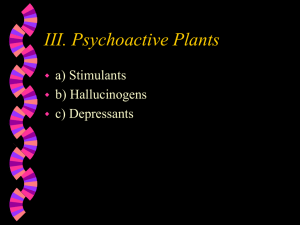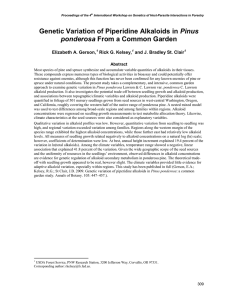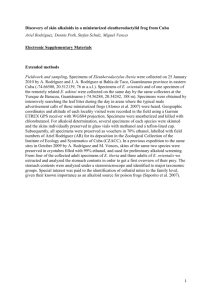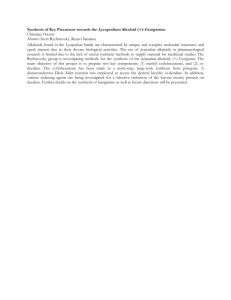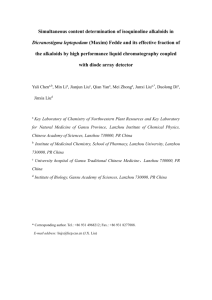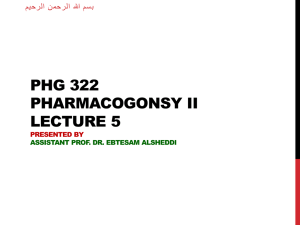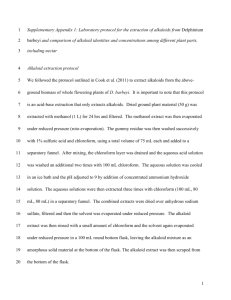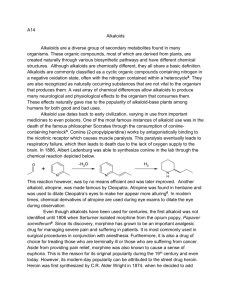Document 13309445
advertisement
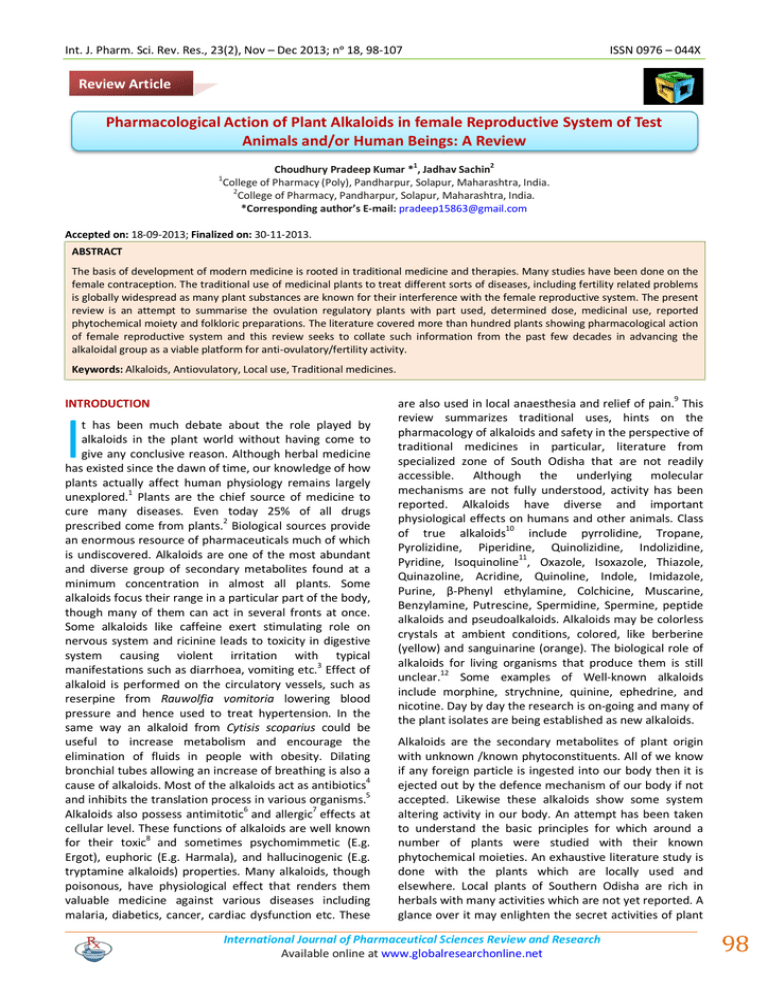
Int. J. Pharm. Sci. Rev. Res., 23(2), Nov – Dec 2013; nᵒ 18, 98-107 ISSN 0976 – 044X Review Article Pharmacological Action of Plant Alkaloids in female Reproductive System of Test Animals and/or Human Beings: A Review 1 1 2 Choudhury Pradeep Kumar * , Jadhav Sachin College of Pharmacy (Poly), Pandharpur, Solapur, Maharashtra, India. 2 College of Pharmacy, Pandharpur, Solapur, Maharashtra, India. *Corresponding author’s E-mail: pradeep15863@gmail.com Accepted on: 18-09-2013; Finalized on: 30-11-2013. ABSTRACT The basis of development of modern medicine is rooted in traditional medicine and therapies. Many studies have been done on the female contraception. The traditional use of medicinal plants to treat different sorts of diseases, including fertility related problems is globally widespread as many plant substances are known for their interference with the female reproductive system. The present review is an attempt to summarise the ovulation regulatory plants with part used, determined dose, medicinal use, reported phytochemical moiety and folkloric preparations. The literature covered more than hundred plants showing pharmacological action of female reproductive system and this review seeks to collate such information from the past few decades in advancing the alkaloidal group as a viable platform for anti-ovulatory/fertility activity. Keywords: Alkaloids, Antiovulatory, Local use, Traditional medicines. INTRODUCTION I t has been much debate about the role played by alkaloids in the plant world without having come to give any conclusive reason. Although herbal medicine has existed since the dawn of time, our knowledge of how plants actually affect human physiology remains largely unexplored.1 Plants are the chief source of medicine to cure many diseases. Even today 25% of all drugs prescribed come from plants.2 Biological sources provide an enormous resource of pharmaceuticals much of which is undiscovered. Alkaloids are one of the most abundant and diverse group of secondary metabolites found at a minimum concentration in almost all plants. Some alkaloids focus their range in a particular part of the body, though many of them can act in several fronts at once. Some alkaloids like caffeine exert stimulating role on nervous system and ricinine leads to toxicity in digestive system causing violent irritation with typical manifestations such as diarrhoea, vomiting etc.3 Effect of alkaloid is performed on the circulatory vessels, such as reserpine from Rauwolfia vomitoria lowering blood pressure and hence used to treat hypertension. In the same way an alkaloid from Cytisis scoparius could be useful to increase metabolism and encourage the elimination of fluids in people with obesity. Dilating bronchial tubes allowing an increase of breathing is also a 4 cause of alkaloids. Most of the alkaloids act as antibiotics 5 and inhibits the translation process in various organisms. 6 7 Alkaloids also possess antimitotic and allergic effects at cellular level. These functions of alkaloids are well known 8 for their toxic and sometimes psychomimmetic (E.g. Ergot), euphoric (E.g. Harmala), and hallucinogenic (E.g. tryptamine alkaloids) properties. Many alkaloids, though poisonous, have physiological effect that renders them valuable medicine against various diseases including malaria, diabetics, cancer, cardiac dysfunction etc. These are also used in local anaesthesia and relief of pain.9 This review summarizes traditional uses, hints on the pharmacology of alkaloids and safety in the perspective of traditional medicines in particular, literature from specialized zone of South Odisha that are not readily accessible. Although the underlying molecular mechanisms are not fully understood, activity has been reported. Alkaloids have diverse and important physiological effects on humans and other animals. Class of true alkaloids10 include pyrrolidine, Tropane, Pyrolizidine, Piperidine, Quinolizidine, Indolizidine, Pyridine, Isoquinoline11, Oxazole, Isoxazole, Thiazole, Quinazoline, Acridine, Quinoline, Indole, Imidazole, Purine, β-Phenyl ethylamine, Colchicine, Muscarine, Benzylamine, Putrescine, Spermidine, Spermine, peptide alkaloids and pseudoalkaloids. Alkaloids may be colorless crystals at ambient conditions, colored, like berberine (yellow) and sanguinarine (orange). The biological role of alkaloids for living organisms that produce them is still unclear.12 Some examples of Well-known alkaloids include morphine, strychnine, quinine, ephedrine, and nicotine. Day by day the research is on-going and many of the plant isolates are being established as new alkaloids. Alkaloids are the secondary metabolites of plant origin with unknown /known phytoconstituents. All of we know if any foreign particle is ingested into our body then it is ejected out by the defence mechanism of our body if not accepted. Likewise these alkaloids show some system altering activity in our body. An attempt has been taken to understand the basic principles for which around a number of plants were studied with their known phytochemical moieties. An exhaustive literature study is done with the plants which are locally used and elsewhere. Local plants of Southern Odisha are rich in herbals with many activities which are not yet reported. A glance over it may enlighten the secret activities of plant International Journal of Pharmaceutical Sciences Review and Research Available online at www.globalresearchonline.net 98 Int. J. Pharm. Sci. Rev. Res., 23(2), Nov – Dec 2013; nᵒ 18, 98-107 alkaloids. Around 100 of medicinal plants with their details are displayed in a tabular form to gain a knowledge which may be helpful in the field of research for new findings. Eastern Ghats of South Odisha is having such type of plants which are never eye viewed for ISSN 0976 – 044X research. Among many interpretations, the possibility of an effective check up on reported as well as folkloric use of plants by the local people of South Odisha may be realized. Table 1: Antifertility / Antiovulatory and Related Activities of Some Plants with Their Active Principles and Potion that have been reported from local plants of Malkangiri, Odisha Name of the plant Family Local Name (Oriya) Part used Medicinal use preparation and dosage form Type of use Reported phytochemical moiety Reversible alterations in the estrous cycle pattern and completely blocked ovulation in SpragueDawley rats 5gm of paste orally used External/ internal Indole alkaloid 16 Abrine Okoko , 2010 post coital Antifertility 600mg/ kg body wt. internal pyranoquinoline 17 alkaloid Hiremath SP, 1999 various Internal Author/Year Abrus precatorius Fabaceae Kaincha Leaves and seed Acalypha indica Euphorbia ceae Nakachan a Leaves, root, stalk (young shoots) and flowers. Achyranthe s aspera Aerva lanata Amarantha ceae Amarantha ceae Apamara ng Whole plant Paunsia Aerial parts Abortifacient No report Internal Ailanthus excella Simarouba ceae Dakhinak abata Stem bark Antiovulatory No report external/ internal Alangium salvifolium Cornaceae (Alangicea e) Ankula Stem bark Contraceptive and abortifacient, antiprogesterogenic activity No report internal Allium cepa Alliaceae Piaja Bulb Antifertility, anti implantation effect 300 mg/kg external and internal Alliins Amaranthu s spinosus Amarantha ceae Kanta marisha Leaves Abortifacient No report internal Alkaloids Anamirta coculus Menisper maceae Kakamari Tender leaves Contraction of uterus No report external Annona squamosa Annonacea e Sitaphala seeds, leaves, bark Abortifacient No report Internal Antiaris toxicaria Moraceae Bhramara mari Roots Antifertility No report Internal Areca catechu Arecaceae Gua Fruit / seed Anti-ovulatory No report Internal Arecaidine Contraceptive, Antifertility No report External and internal Cyclopeptide 21 alkaloid Saravan, et al. 2012 Abortifacient 300/600 mg/kg Internal Steroid 27 alkaloid Padmashali, et al 2006 Abortifacient 250/500 mg/kg Internal Alkaloid 28 Musa et al. 2009 No report Internal No report Chaudhary et a.l 2012 Seeds, leaves, flowers and bark Bark, fruit seed, leaves of the tree and the oil from seeds Abortifacient 18 19 Achranthine canthin-6-one 20 alkaloids Benzoquinoline alkaloid: 21 Alancin Benzopyridoqui 21 nolizine Elumalai, (2009) Sasmal, 2011 Saravanan, et al 2012 Saravanan, et al 2012 Saravanan, et al 2012 21 22 Protoberberine 23 alkaloid Atrophine alkaloids, 24 Anonaine Tropane alkaloid Aristolactum glucoside and p25 coumaric acid 26 Balakrisnan, 2011 http://www.ayus hveda.com/herbs /anamirtacocculus.htm Vijayalaxmi, et al 2011 www.niir.org Jyoti, et al. 2010 Azadirachta indica Meliaceae Nimba Balanites roxburghii Zygophylla ceae Kampani poi Poaceae Baunsa Leaves Bombacec eae Simili, Bura Root Abortion Fabaceae Palasa Seed Antifertility 100 mg / kg Internal Isoquinoline 1 ,29 alkaloid Razdan, et al.1969 Cannabace ae Ganjei Leaves Antifertility, Abortifacient 125, 200, 400 and 800 mg/kg Internal Anhydrocannabi 30 sativine Sethi, et al.1991 Bambusa vulgaris Bbmbax ceiba Butea manosperm a Cannabis sativa 38 International Journal of Pharmaceutical Sciences Review and Research Available online at www.globalresearchonline.net 99 Int. J. Pharm. Sci. Rev. Res., 23(2), Nov – Dec 2013; nᵒ 18, 98-107 ISSN 0976 – 044X Table 1: Antifertility / Antiovulatory and Related Activities of Some Plants with Their Active Principles and Potion that have been reported from local plants of Malkangiri, Odisha (Continued.....) Part used Medicinal use preparation and dosage form Type of use Seed Irregular menstruation No report Internal Sajira Seeds Oestrous cycle 32 Disruptor No report internal Fabaceae Sunari Fruits, bark Anti-implantation activity, estrogenic activity 100mg/kg Internal Fabaceae Kasendri Root Antispermatogenic No report Internal Menisper maceae Akanabin di Leaf, root Antifertility agent 7.3 g/kg Internal Name of the plant Family Carica papaya Caricaceae Carum carvi Apiaceae Cassia fistula Cassia occidentalis Cissampelo s pareira Local Name (Oriya) Amrutabh anda Anti-fertility, partial and complete resorption of implants Crataeva nurvala Capparidac eae Boruno Stem bark Crotalaria juncea Fabaceae Tumuka Seeds Croton roxburghii Euphorbiac eae Bhutala Bark/Latex Curcuma longa zingiberac eae Haldi Rhizome Datura starmoniu m Solanacea e Dudura Leaf Daucus carota apiaceae Gajoro Loranthace ae Madanga fabaceae Karanja Ferula foetida Apiaceae Hingu Latex Abortifacient Ficus racemosa Moraceae Dimiri Bark Anti-fertility Gloriosha superba Lilaceae Langalang lia Rhizome Abortifacient, Oxytocic Gossypium herbaceum malvaceae Kapa Seed/coma Hibiscus rosasinensis Malvaceae Mandara Lawsonia inermis Lythraceae Reported phytochemic al moiety 31 Carpaine Isoquinoline 21 alkaloid 33 Alkaloid Isoquinoline 34 alkaloid Thirty seven 21 alkaloids 300 and 600 mg/kg 21 Author/Year Burdick,1971 Saravanan, et al 2012, Ankush et al 2011 Panda, et al 2011 Rajendradeep, et al 2011 Saravanan.et al 2012, Saravanan, et al 2012 Internal Cadabicine 25 mg/100 g body weight Internal Riddelliine No report No report 10-15 grams powder per day for 5 days after mense Internal Alkaloids 37 Amit, et al., 2011 Antiestrogenic No report No report Alkaloids 38 Soni, et al., 2012 Seed contraceptive No report No report Pseudobenzyl -isoquinoline 21 alkaloid Saravanan, et al 2012 Leaf Contraceptive 50/100/200 mg/Rat Internal ? Gupta, et al 2007 200 / 600 Internal ? Variable Suppositor y Oleoresin 50 / 100 mg Internal ? 550 mg Internal 1,2 Didemethyl43 colchicine: Abortifacient Variable Suppositor y ? Root, flower Anti-implantation activity 400mg/kg internal Cyclopeptide 44 alkaloid Manjuati leaves Abortifacient Variable Internal Alkaloid Lamiaceae Pudina Leaves Anti-implantation 100mg/kg Internal Alkaloid Lamiaceae Pudina Leaves Contraceptive No report Internal No report Mimosa pudica Fabaceae Lajakulilat a Leaf/Root Abortion Variable Internal No report Momordica charantia Momordica cymbalaria Cucurbitac eae Cucurbitac eae Kolora Seed No report No report No report Pitta janhi No report 250,500mg/ 32 kg Internal No report Dendrothoe falcata Derris brevipes Mentha arvensis Mentha pulegium Antispermatogenic and antisteroid-ogenic activities, anti-ovulatory anti- ovulatory Anti-ovulatory 21 36 39 Anti-fertility 40 41 42 8 46 Anti-implantation Estrous cycle disrupturer 35 No report 45 46 International Journal of Pharmaceutical Sciences Review and Research Available online at www.globalresearchonline.net http://ntp.niehs. nih.gov/go/roc12 Saravanan, et al 2012 Badami, et al 2003 Personal collection(Folklor e) Personal collection(Folklor e) Choudhury,1993; Arati, et al., 2011 Personal collection(Folklor e) Neeru basudeva, et al 2007 Personal collection(Folklor e) Ankush, et al 2011 Verissimo, 2011 Personal collection(Folklor e) Ankush, et al. 2011 Ankush, et al. 2011 100 Int. J. Pharm. Sci. Rev. Res., 23(2), Nov – Dec 2013; nᵒ 18, 98-107 ISSN 0976 – 044X Table 1: Antifertility / Antiovulatory and Related Activities of Some Plants with Their Active Principles and Potion that have been reported from local plants of Malkangiri, Odisha (Continued.....) Name of the plant Family Local Name (Oriya) Part used Medicinal use preparation and dosage form Type of use Reported phytochemica l moiety Author/Year Momordica tuberosa Cucurbitac eae Jahni Leaf Antiovulatory Variable Internal No report Personal collection (Folklore) Nelumbo nucifera Nymphaea ceae Padma Petal, seed, leaves, root 0.5,1,2g/kg Internal Bis-benzylisoquinoline alkaloid Ankush, et al 2011 Latex 5 to 25 days after…. Internal Noscapine 47 alkaloid 200400mg/kg Internal ? 200/400 mg Internal ? Antioestrogenic 46 Papaver sominiferu m Plumbago rosea Plumbago zeylanica Papaverac eae Aphima Plumbagin aceae Plumbagin aceae Rakta chitaparu Swetachit aparu Piper betel Piperaceae Pana Stalk Anti-oestrogenic Variable Suppositor y No report Ricinus communis Euphorbia ceae Gaba Seed Abortifacient, anti50 implantation 0.6g and 1.2g per kg Internal Ricinine, 51 isoquinoline Sesbania sesban Fabaceae Agasti seed Fertility control 100 , 250 and 400mg/kg No report Tabernaem ontana divaricate Apocynace ae Tagara Root Abortifacient Variable Internal No report Tamarindus indica Caesalpini aceae Tentuli Bark Abortifacient Variable Internal No report Tinospora cordifolia Menisper maceae Guluchi Stem Antifertility No report No report Protobeberine alkaloid (Isoquinoline) Fabaceae Methi Seed/Leaf No report Internal Lythraceae Dhatuki Flower No report No report Zingiberac eae Ada Rhizome Abortion Rhamnace ae Barakoli Root bark Abortion Acacia polycantha Fabaceae Sami kanta Leaf Ananas cosmosis Bromiliace ae Sapuri Leaf Apium graveolens Apiaceae Bana juani Aerial parts Anti-ovulatory Bauhinia racemosa Caesalpini aceae Kanchana Stem bark Calotropis gigantia Asclepiada ceae Akanda Calotropis procera Asclepiada ceae Citrullus colocynthis Cucurbitac eae Trigonella foenumgracecum Woodfordia fruticosa Zingiber officinalis Zizyphus jujuba Antiovulatory Leaves Antiovulatory Root bark Abortion 48 49 52 54 Alkaloids 53 Ibrahim Bulduk and Fulya Taktak 2013 Sheeja, et al., 2009 Sheeja, et al., 2009 Personal collection(Folklor e) Assefa, et al. 1999;Mcneil et al., 2003 Mythili, et al ., 2012 Personal collection(Folklor e) Personal collection(Folklor e) Gupta, et al 2003 Trigonelline 55 Zhuo et al 2010 Matrine type 18 alkaloid Alkaloid 57 (Unknown) Pakrashi, et al.1977 Bhargava et al., 2012 No report Cyclopeptide 58 alkaloid T. Pullaiah 2003 hormonal imbalance 150 / 300 / 600mg / kg External/ internal claims DMT ( dimethyl tripta-mine) in Plant, Psychoactive alkaloid Brock et al,2002 Abortifacient Variable Internal No report No report No report Unidentified Abortifacient Variable Internal No report Root abortifacient Variable Suppositor y No report Arakha Root antiovulatory (25, 50 and 100 mg/kg of dry roots Internal steroidal 60 alkaloid Mahankal a Fruit,seed Abortifacient No report No report No report 56 Abortifacient powder 2 gram daily Powdered root bark 35 g twice daily 59 internal Alkaloids International Journal of Pharmaceutical Sciences Review and Research Available online at www.globalresearchonline.net 61 Personal collection(Folklor e) Open homeo encyclopaedia project Personal collection (Folklore) Personal collection (Folklore) Circosta, et al 2001 Agrawal, Natural Drugs 101 Int. J. Pharm. Sci. Rev. Res., 23(2), Nov – Dec 2013; nᵒ 18, 98-107 ISSN 0976 – 044X Table 1: Antifertility / Antiovulatory and Related Activities of Some Plants with Their Active Principles and Potion that have been reported from local plants of Malkangiri, Odisha (Continued.....) Name of the plant Cocos nucifera Lantana camara Melia azadirachta Mimosa pudica Family Local Name (Oriya) Part used Medicinal use preparation and dosage form Type of use Reported phytochemica l moiety Author/Year Arecaceae Nadia Fruit fibre Abortifacient No report No report No report Obidoa , 2010 Verbenace ae Bhutiari kanta Mahanim ba Noreport Internal No report Mello et al., 2005 5/10/20 mg/kg Internal No report Meliaceae Leaf Seed Antifertility/ Embryo 62 toxicity Reduction in fertility 63 index Dhaliwal, et at. 2007 Ankush, et al. 2011 Personal Collection (Folk lore) Personal Collection (Folk lore) Personal Collection (Folk lore) Personal Collection (Folk lore) Kapoor , et al. 1974 (Jewers, et al., 1976). Fabaceae Lajakuli root Anti ovulatory No report No report mimosine Moringa oleifera Moringace ae Sajana / Muniga Flowers Abortifacient Variable Internal No report Nerium indicium Apocynace ae Karabira Leaves Abortifacient Variable Internal No report Pergularia daemia Asclepiada ceae Uturudi root Anti-fertility Variable Internal No report Phyllanthus amarus Euphorbia ceae Bhuin nimba Whole plant Arrests normal oestrous cycle Variable Internal No report Polygonum hydropiper Prosopis cineraria Stephania japonica Trichosanth es cucumerina Dysoxylum binectarifer um Solanum tuberosum Solanum lycopersicu m Solanum melongena Polygonac eae Mimosace ae Menisper maceae Pani saga Root powder Anti-oestrogenic Variable Internal No report Sami Fruit, root Abortion Variable Internal Spicigerine Dahidahia Leaf Abortifacient Variable No report Hasubanan alkaloid Yasuo, et al 1975 Cucurbitac eae Banapotol a Whole plant 200/400mg Internal not clearly identified Kage, et al. 2009 Meliaceae Bandardewa Stem bark Anti-implantation 10mg/kg Internal Rohitukine Solanacea e Alu Leaves,Stem , Shoot No report No report No report Solanine Solanacea e Tomoto Leaves,Stem ,Unripe fruit No report No report No report Tomatine Solanacea e Baigana Flower, Leaves No report No report No report Solanine Solanum dulcamara Solanacea e Bheji baigana Fruit,Flower, Root No report No report No report Solanine,solas odine,beta14 solamarine Tylophora indica Apocynace ae Antamula Root Abortifacient No report No report Tylophorine Sharma et al., 2012 Jude Chigozie Ikewuchi, 2012 Mucuna pruriens Tridax procumben s Cuscuta reflexa Anti-ovulatory 65 64 66 Alexander et al., 2009 15 67 68 Fabeaceae Baidanka All parts No report No report No report mucunine, mucunadine, prurienine and 69 prurienine Asteraceae Bisalyakar ani Leaves No report No report External Thirty nine 70 alkaloids Convolvula ceae Nirmuli Entire plants No report No report No report A short review of plants is presented and it was found that alkaloids are the only phytoconstituents in every reported plant, may be responsible for altering the reproductive systems in test animals and/or human. The particular plant parts of Senecio jacobaea, Striga orobanchioides, Petroselinum hortenseand Momordica cymbalaria containing alkaloid have no information about 13 the antiovulatory use. Mendel et al., 1995 Sharma et al., 2009 14 Alkaloids Keshri et al., 2007 71 Sharma et al., 2009 chandigarh.nic.in /pdf/medicinalplants.pdf Baumel et al., 1995 The plants like Senecio jacobaea,Bombax ceiba, Tinospora cordifolia and Trigonella foenum- gracecum rich in alkaloids have no clear-cut medicinal use. The plants such asAerva lanata, Ailanthus excella, Alangium salvifolium, Amaranthus spinosus,Anamirta coculus, Annona squamosal, Antiaris toxicaria, Areca catechu, Azadirachta indica, Bbmbax ceiba, Carica papaya, Carum carvi, Cassia occidentalis, Croton International Journal of Pharmaceutical Sciences Review and Research Available online at www.globalresearchonline.net 102 Int. J. Pharm. Sci. Rev. Res., 23(2), Nov – Dec 2013; nᵒ 18, 98-107 roxburghii, Datura starmonium, Daucus carota, Mentha pulegium, Momordica charantia, Tinospora cordifolia, Trigonella foenum- gracecum, Woodfordia fruticosa, Apium graveolens, Citrullus colocynthis, Cocos nucifera, Lantana camara, Mimosa pudica, Aspilia Africana, Bombax ceiba, Cimicifuga racemosa, Cnidoseolaus ISSN 0976 – 044X aconitifolius, Coulophyllum thalictorides, Malvaviscus conzattii, Peganum harmala, Petroselinum hortense, Rhynchosia minima, Senecio jacobaea andTaxus baccata have no established reports relating to its preparation, dose determination and dosage forms. Table 2: Antifertility / Antiovulatory and related activities of some plants with their active principles and potion that have been reported from elsewhere. Name of the plant Family Local Name (Oriya) Part used Medicinal use preparation and dosage form Type of use Reported phytochemical moiety Author/Year Achillea millefolium Asteraceae No report Herb Emmenagogue 3 gm daily internal Bitter glycol alkaloid 72 Achilleine European Medicines Agency Leaf Inflammation of fallopian tube, degeneration in ovarian cortex (stroma cells ) and disruption of the endometrial uterus No report No report Aspilia africana Asteraceae Bombax ceiba Bombacace ae No report Stem No report No report No report Cimicifuga racemosa Ranunculac eae No report Roots, rhizome s Antioestrogenic/ antiovulatory No report No report Cimipronidine, a cyclic 75 guanidine alkaloid Xu H et a.,l 2005 No report internal alkaloids, saponins, phenolics, tannins, flavonoids, anthraquinones phlobatannins, 21 triterpenes Saravanan, et al 2012 No report No report 350 / 1500 / 2000 mg Internal alkaloid No report Internal No report No report Cnidoseola us aconitifoliu s Coulophyll um thalictorid es Gracinia kola Malvaviscu s conzattii Peganum harmala Petroselinu m hortense Rhynchosia minima Rivea hypocrater iformis Rosmarinu s officinalis Rumex steudelii Salvia fructosa Senecio jacobaea Striga orobanchio ides Taxus baccata Nigella sativa No report 6% Active principles Some alkaloids 73 74 Abii et al.2011 Himalayan drug company, herbal monograph Euphorbiac eae No report Leaves Adverse effect on the maturation and ovulation of follicles Berberidac eae No report Herb Abortive, contraceptive, embriotoxic Clusiaceae No report Seed Alters oestrous cycle Malvaceae No report Flower Anti-ovulatory Nitrariacea e No report Seed , root Abortifacient 2.5g/kg 16 Internal Apiaceae No report No report Anti ovulatory No report Internal Fabaceae No report Leaves Abortifacient 81 No report No report No report Convolvula ceae No report Aerial parts Anti-implantation 200/400mg/k g Internal No report Shivalingappa, et al 2001 Lamiaceae No report Leaves large quantity Internal Indole alkaloid (rosmaricine) PFAF database Polygonace ae No report Root Lamiaceae No report Leaves Asteraceae No report Scrophulari aceae 77 78 79 82 Abortifacient http://www.na turalstandard.c om 76 Taspine 80 peculiar alkaloid 83 Ovarian follicular 84 genesis Reproductive toxicity 85 potentials 3gm/kg Internal No report 200,400 and 800mg Internal No report No report No report No report Externa l Pyrolizidine No report No report Increase in uterine weight 25 mg/kg Internal No report Taxaceae No report Leaves Anti-ovulatory No report Internal Three Pseudo alkaloids 87 (taxane?) Ranunculac eae Kalazira Seeds Antioxytocic Variable Internal 88 86 89 Nigellimine International Journal of Pharmaceutical Sciences Review and Research Available online at www.globalresearchonline.net Braide et al.2003 Banaree, et al. 1999 Shapira ,et al. 1989 MysticWays Wiki Pagan Knowledgebas e Tarafdar et al. 1983 Solomon et al. 2010 Al-Hamoodet al. 1998 www.herbvide os. .com Ankush et al. 2011 Giovanni et al. 1993 Rahman et al. 1992 103 Int. J. Pharm. Sci. Rev. Res., 23(2), Nov – Dec 2013; nᵒ 18, 98-107 ISSN 0976 – 044X Table 2: Antifertility / Antiovulatory and related activities of some plants with their active principles and potion that have been reported from elsewhere. Name of the plant Cissampelo s pareira Lepidium sativum Tussilago farfara Family Menisperm aceae Brassicacea e Asteraceae Local Name (Oriya) Akanabindi Chandasara ? Part used Leaf, root mature explants coltsfoo t Medicinal use preparation and dosage form Type of use Reported phytochemical moiety Antifertility agent 7.3 g/kg Internal Thirty seven alkaloids Anti-ovulatory Variable No report Lepidine ? ? ? Senecionine 4 90 91 Author/Year Saravanan.et al 2012, Srivastava et al., 2002 EFSA 2011 Note:(?)- Indicates unconfirmed data; No report: indicates unspecified items in the literature; Variable: indicates varied used potions. The internal or external use ofconstituents from Croton roxburghii, Datura starmonium, Daucus carota, Momordica charantia, Sesbania sesban, Tinospora cordifolia, Woodfordia fruticosa, Zizyphus jujube, Apium graveolens, Citrullus colocynthis, Cocos nucifera, Mimosa pudicaandStephania japonicaare not yet optimized. Similarly the phytochemical moieties of Bbmbax ceiba, Croton roxburghii, Mentha pulegium, Mimosa pudica, Momordica charantia, Momordica cymbalaria, Momordica tuberosa, Piper betel, Tabernaemontana divaricate, Tamarindus indica, Ananas cosmosis, Bauhinia racemosa, Calotropis gigantia, Cocos nucifera, Lantana camara, Melia azadirachta, Moringa oleifera, Nerium indicium, Pergularia daemia, Phyllanthus amarus, Polygonum hydropiper, Malvaviscus conzattii, Peganum harmala, Rhynchosia minima, Rivea hypocrateriformis, Rumex steudelii, Salvia fructose and Striga orobanchioides are not investigated thoroughly. Here, someplants having routine use of human beings are personally collected viz :Ferula foetida, Gossypium herbaceum, Lawsonia inermis, Mimosa pudica, Momordica tuberosa, Piper betel, Tabernaemontana divaricate, Tamarindus indica, Ananas cosmosis, Bauhinia racemosa, Calotropis gigantia, Moringa oleifera, Nerium indicium, Pergularia daemia and Phyllanthus amarus.Folkloric use of these plants are very popular for their active phytoconstituents may be with alkaloid as chief constituent which definitely alters the reproductive system of test animals and/or human beings. These plants should be more explored in future for the new findings. Latest scientific introspection Tussilago farfara belonging to family Asteraceae contains tumorigenic pyrrolizidine alkaloids. There are documented cases of Coltsfoot tea causing severe liver problems in an infant, and in another case, an infant developed liver disease and died because the mother drank tea containing coltsfoot during her pregnancy . Hence the alkaloid Senecionine may be researched for antiovulatory potentials. Solanine occurs naturally in many species of the genus Solanum, including the potato (Solanum tuberosum), tomato (Solanum lycopersicum). Scant evidence for tomato toxicity is reported in the medical and veterinary literature and the same alkaloid Solanine is found in eggplant (Solanum melongena), nightshade (Solanum dulcamara). and bittersweet The alkaloids from Solanum dulcamara, solanine (from unripe fruits), solasodine (from flowers) and betasolamarine (from roots) inhibited the growth of E. coli 14 and S. Aureus. Although fatal human poisonings are rare, several cases have been documented. The poison is believed to be solanine.15 The review suggests that unlike medicines every food or vegetable must be within therapeutic index for its safe use. Further any food or vegetable which contains alkaloids must be analysed and a threshold is to be fixed for their safe. CONCLUSION Medicinal plants constitute the base of health care systems in many societies. The recovery of the knowledge and practices associated with these plant resources are part of an important strategy linked to the conservation of biodiversity, exploring new medicines and getting a new pathway for awareness of health systems. The folkloric use of such potion with several aspects is discussed. However the problems related to efficacy, isolation of active phytoconstituents, dose determination etcetera are required to be tested and established for their right use. The research in pharmacokinetics and pharmacodynamics of such plant moieties are necessary to be established in a newer dosage form and must be safe for its use. The list of medicinal plants used to alter the reproductive system asantifertility/ antiovulatory/ any other agents presented in this review which is useful to researchers, as well as practitioners. Emphasis should be laid to investigate plant species that have not been subject of pharmacological studies, although the folkloric uses are popular. It may be concluded that the plants rich in alkaloidal moiety may be explored for its hidden activities in the field of research. REFERENCES 1. Priyashree S, Jha S, Pattanayak SP, A review on Cressa cretica Linn.: A halophytic plant. Pharmacogn Rev., 4(8), 2010, 161– 166. 2. S.M.K. Rates, Review, Plants as source of drugs, Toxicon, 39(5), 2001, 603–613. 3. www.botanical-online.com/english/alkaloids.htm 4. García MT, Blázquez MA, Ferrándiz MJ, Sanz MJ, Silva-MN, Hermoso JA, de la Campa AG, New alkaloid antibiotics that International Journal of Pharmaceutical Sciences Review and Research Available online at www.globalresearchonline.net 104 Int. J. Pharm. Sci. Rev. Res., 23(2), Nov – Dec 2013; nᵒ 18, 98-107 target the DNA topoisomerase I of Streptococcus pneumonia, J Biol Chem., 286(8), 2011, 6402-6413. 5. Fresno M, Jiménez A, Vázquez D, Inhibition of translation in eukaryotic systems by harringtonine, Eur J Biochem., 72(2), 1977, 323-330. 6. Tits M, Desaive C, Marnette JM, Bassleer R, Angenot L, Antimitotic activity of strychnopentamine, a bisindolic alkaloid, J Ethnopharmacol, 12(3), 1984, 287-292. 7. Chukaew A, Ponglimanont C, Karalai C, Tewtrakul S. Potential anti-allergic acridone alkaloids from the roots of Atalantia monophylla, Phytochemistry, 69(14), 2008, 2616-2620. 8. Verissim LF, Andre D, Bacchi TZ, Gustavo HOP, Estefania GM, Herbs of interest to the Brazilian Federal Government: female reproductive and developmental toxicity studies, Brazilian Journal of Pharmacognosy, 21(6), 2011, 1163-1171. 9. Takrouri MSM, Mohamad Said Maani MB, ChB, Anesthetic Uses of Hyoscine and Atropine Alkaloids in Surgical Arabic Book, Anesthesiology, 90(6), 1999, 1795. 10. Plemenkov, VV, Introduction to the Chemistry of Natural Compounds, Kazan, 2001, 223. 11. Kenneth WB, "β-Phenylethylamines and the isoquinoline alkaloids", Nat. Prod. Rep, 14 (4), 1997, 387–411. 12. Tadeusz Aniszewski, Alkaloids - Secrets of Life -1st Edison, 2007, 142. 13. Kapoor M, Garg SK, Mathur VS, Antiovulatory activity of five indigenous plants in rabbits, Ind J Med Res., 62(8), 1974, 12251227. 14. Sharma B, Kumar P, Bakshi N, "Biological activity of alkaloids from Solanum dulcamara", Natural Product Research, 23(8), 2009, 719-723. 15. Alexander RF, Forbes GB, Hawkins ES, "A Fatal Case of Solanine Poisoning", British Medical Journal, 2 (4575), 1984, 518. 16. Okoko II, Osinubi AA, Olabiyi OO, Kusemiju TO, Noronha CC, Okanlawon AO, "Antiovulatory and anti-implantation potential of the methanolic extract of seeds of Abrus precatorius in the rat", Endocrine practice, official journal of the American College of Endocrinology and the American Association of Clinical Endocrinologists, 16(4), 2010, 554-560. 17. Hiremath SP, Rudresh K, Badami S, Patil SB, Patil SR, Post-coital antifertility activity of Acalypha indica Linn., J Ethnopharmacol, 67(3), 1999, 253-258. 18. Pakrashi A, Bhattacharya N, ABIM - An Annotated Bibliography of Indian Medicine abortifacient activity; Abortifacient principle of Achyranthes aspera Linn, IJEB, 15(10), 1977, 856858. 19. Elumalai EK, Chandrasekaran N, Thirumalai T, Sivakumar C, Therasa SV, David E, Achyranthes aspera leaf extracts inhibited fungal growth, International Journal of PharmTech Research, 1(4), 2009, 1576-1579. 20. Sasmal D, Goyal M, Pareek A, Nagori BP, Aerva lanata: A review on phytochemistry and pharmacological aspects. Pharmacogn Rev. 5(10), 2011, 195–198. 21. Saravanan, Priya G, Renuka C, Medicinal plants with potential antifertility activity – A review of sixteen years of herbal medicine research (1994-2010), IJPTR, 1(1), 2012, 481-494. 22. Sangameswaran B, Balakrishnan N, Balasubramaniam, Arumugam, Hariram BV, Pharmacognostical evaluation of Amaranthus spinosus L. Pharmacognosy Journal, 3 (19), 2011, 13-18. ISSN 0976 – 044X 23. http://www.ayushveda.com/herbs/anamirta-cocculus.htm. 24. Vijayalakshmi K, Vanitha V, Umadevi KJ, Determination of Bioactive Components of Annona squamosa L Leaf by GC- MS Analysis, International Journal of Pharmaceutical Sciences and Drug Research, 3(4), 2011, 309-312. 25. www.niir.org 26. Jyoti S, Tara S, Smita S, Arul A, Krishanananda P, Stuti S, Samik B, Sajala K, Antiovulatory and abortifacient effects of Areca catechu (betel nut) in female rats, Indian Journal of Pharmacology, 42(5), 2010, 306-311. 27. Padmasali S, Vaidya P, Vagdevi HM, Sathyanarayana MD, Antifertility effect of the plant Balanites Roxburghii (Balanitaceae) in female albino rats, Indian J Pharmacol, 68 (3), 2006, 347-351. 28. Musa TY, Bimbo BB, Abortifacient potentials of the aqueous extract of Bambusa vulgaris leaves in pregnant Dutch rabbits, Contraception, 80 (3), 2009, 308–331. 29. Razdan MK, Kanti K, Bhide NK, Antifertility effect and some pharmacological actions of Butea frondosa seed extracts, Ind Jour of Physiol and Pharmacol, 13(4), 1969, 239-249. 30. Sethi N, Nath D, Singh RK, Srivasta RK, Antifertility and Teratogenic Activity of Cannabis Sativa In Rats, PAGINATION/COLLATION, 62(1), 1991, 69-73. 31. Burdick EM, "Carpaine.An alkaloid of Carica papaya, Chemistry and pharmacology." Economic Botany, 25(4), 1971, 363-365. 32. Ankush R, Singh A, Sharma A, Singh N, Kumar P, Bhatia V, Antifertility activity of Medicinal plants on Reproductive System of Female Rats, Internat Jour of Bio Engineering Sci and Tech, 2(1), 2011, 44-50. 33. Panda SK, Padhi LP, G Mohanty G, Antibacterial activities and phytochemical analysis of Cassia fistula (Linn.) leaf. J Adv Pharm Technol Res, 2(1), 2011, 62-67. 34. Rajandeep K, Sharma A, Kumar R, Khar R, Plant Resour, Rising Trends towards Herbal Contraceptives, J. Nat. Prod, 1(4), 2011, 5-12. 35. http://ntp.niehs.nih.gov/go/roc12 36. Ghosh AK, Das AK, Patra KK, Studies on antifertility effect of rhizome of curcuma longa linn, Asian Journal of Pharmacy and Life Science, 1(4), 2011, 349-353. 37. Saraf DK, Shweta T, Bhavana B, Aditi D, Durgesh N, Nagendra SC, Effect of Carum carvi and Curcuma longa on hormonal and reproductive parameter of female rats, International Journal of Phytomedicine, 1(1), 2009, 31-38. 38. Soni V, Soni P, Siddiqui AA, Dwivedi J, Antiovulatory and estrogenic activity of leaves of Datura stramonium Linn.in female albino rats, Asian Pacific Jour of Trop Biomed, 2012, 15. 39. Gupta RS, Kachhawa JB, Sharma A, Effect of methanolic extract of Dendrophthoe falcata stem on reproductive function of male albino rats, J Herb Pharmacother, 7(2), 2007, 1-13. 40. Badami S, Aneesh R, Sankar S, Sathishkumar MN, Suresh B, Rajan S, Antiferitility activity of Derris brevipes variety coriacea, J. Ethnopharmacol, 84(4), 2003, 99-104. 41. Ahirwar D, Kharya MD, Ahiwar B, Reversible Antifertility Activity of Hydroalcoholic Extract of Ficus Racemosa L. in Male Mice, Journal of Reproduction and Contraception, 22(8), 2011, 37-44. 42. Bodhankar SL, Malpani AA, Aswar UM, Kushwaha SK, Zambare GN, Effect of the Aqueous Extract of Gloriosa superba Linn International Journal of Pharmaceutical Sciences Review and Research Available online at www.globalresearchonline.net 105 Int. J. Pharm. Sci. Rev. Res., 23(2), Nov – Dec 2013; nᵒ 18, 98-107 ISSN 0976 – 044X (Langli) Roots on Reproductive System and Cardiovascular Parameters in Female Rats, Tropical Journal of Pharmaceutical Research, 10(2), 2011, 169-176. 62. Mello BF, Jacobus D, Carvalho K, Mello JRB, Effects of Lantana camara (Verbenaceae) on general reproductive performance and teratology in rats, Toxicon , 45(4), 2005, 459–466. 43. Chaudhuri PK, Thakur RS, 1,2-Didemethylcolchicine: A New Alkaloid from Gloriosa superb, J. Nat. Prod., 56(7), 1993, 1174– 1176. 63. Dhaliwal PK, Reshu Mandal, Antifertility effect of Melia azedarach Linn. (dharek) seed extract in female Albino rats, Indian Journal of Experimental Biology , 45(10), 2007, 853-860. 44. Neeru V, Sharma SK, Post-Coital Antifertility Activity of Hibiscus rosa-sinensis Linn.Roots, Evid Based Complement Alternat Med., 5(1), 2008, 91–94. 64. Jewers K, Nagler MJ, Nirvi KA, Amir F, Lipids, sterols, and a piperidine alkaloid from Prosopis spicigera leaves, Phytochemistry, 15, 1976, 238–240. 45. CKR Y, Sandya L, Sandeep D, Ruth SK, Nagarjuna S, Reddy PY, Evaluation of diuretic activity of aqueous and ethanolic extracts of Lawsonia inermis leaves in rats, Asian Journal of Plant Science and Research, 1(3), 2011, 28-33. 65. Kage DN, Malashetty VB, Seetharam YN, Suresh P, Patil SB, Effect of ethanol extract of whole plant of Trichosanthes cucumerina var cucumerina Linn. on Gonadotropin, ovarian follicular kinetics and oestrous cycle for screening of antifertility activity in albino rats, Int J Morphol, 27 (1), 2009, 173-182. 46. Ankush R, Singh A, Sharma A, Singh N, Kumar P, Bhatia V, Antifertility activity of medicinal plants on reproductive system of female rats, Int Jour of Bio Engineering Sci. and Tech, 2(3), 2011, 44-50. 47. Ibrahim B, Fulya T, Isolation and Characterization of Antitumor Alkaloid from Poppy Capsules (Papaver somniferum), Journal of Chemistry, 2013 , Article ID 493870, 4. 48. Sheeja E, Joshi SB, Jain DC, Antiovulatory and estrogenic activity of Plumbago rosea leaves in female albino rats, Indian J Pharmacol, 41(6), 2009, 273-277. 49. Edwin S, Joshi SB, Jain DC, Antifertility activity of leaves of Plumbago zeylanica in female albino rats, Eur J Contracept Reprod, Health Care, 14(3), 2009, 33-239. 50. McNeil RT, Noronha CC, Kusemiju TO, Okanlawon AO, The Anti-ovulatory Effect of a Seed Extract of Ricinus Communislinn, Nig. Jnl Health & Biomedical Sciences, 2(1), 2003, 31-34. 51. Makonnen E, Zerihun L, Assefa G, Rostom AA, Antifertility activity of Ricinus communis seed in female guinea pigs, East Afr Med J, 76(6), 1999, 335-337. 52. Singh SP, Fertility control of female through Sesbania sesban seeds, Jour of Res and Edu in Ind Med, 9(4), 1990, 27-32. 66. Keshri G, Oberoi RM, Lakshmi V, Pandey K, Singh MM, Contraceptive and hormonal properties of the stem bark of Dysoxylum binectariferum in rat and docking analysis of rohitukine, the alkaloid isolated from active chloroform soluble fraction, Contraception, 76(5), 2007, 400-407. 67. Mendel F, Carol EL, alpha.-Tomatine Content in Tomato and Tomato Products Determined by HPLC with Pulsed Amperometric Detection, J. Agric. Food Chem., 43(6), 1995, 1507–1511. 68. chandigarh.nic.in/pdf/medicinal-plants.pdf. 69. Sharma BK, Ahmad S, Rahul S, Verma RK, Kumar N, A review on Mucuna pruriens: Its phyto constituents and therapeutic uses, Novel Science International Journal of Pharmaceutical Science, 1(6), 2012, 308 -312. 70. Ikewuchi JC, Alteration of plasma biochemical, haematological and ocular oxidative indices of alloxan induced diabetic rats by aqueous extract of Tridax procumbens linn (Asteraceae), EXCLI journal, 11, 2012, 291-308. 53. Mythili T, Ravindhran R, Phytochemical Screening And Antimicrobial Activity Of Sesbania Sesban (L.), Asian Journal of Pharmaceutical and Clinical, 5(4), 2012, 179-182. 71. Baumel P, Jeschke WD, Rath N, Czygan FC, Proksch P, Modelling of quinolizidine alkaloid net flows in Lupinus albus and between L. albus and the parasite Cuscuta reflexa: new insights into the site of quinolizidine alkaloid synthesis, Journal of experimental botany, 46(292), 1995, 1721-1730. 54. Gupta RS, Sharma A, Antifertility effect of Tinospora cordifolia (Willd) stem extract in male rats, Indian J Exp Biol, 41(8), 2003, 885–889. 72. European Medicines Agency, 12 July 2011, EMA/HMPC/290309/2009 Committee on Herbal Medicinal Products. 55. Zhuo R, Wang L, Wang L, Xiao H, Cai S, Determination of trigonelline in Trigonella foenum-graecum L. by hydrophilic interaction chromatography, Chinese Journal of Chromatography, 28 (4), 2010, 379-382. 73. Abii TA, Onuoha EN, The Chemical Constituents of the Leaf of Aspilia africana as a Scientific Backing to its Tradomedical Potentials, Agricultural Journal, 6(1), 2011, 28-30. 56. Khushalani H, Tatke P, Singh KK, Antifertility activity of dried flowers of Woodfordia fruticosa kurz, Indian Journal of Pharmaceutical Sciences, 68(4), 2006, 528-529. 57. Bhargava S, Kshipra D, Amla B, Asha S, Bharti M, Zingiber Officinale: Chemical and phytochemical screening and evaluation of its antimicrobial activities, Journal of Chemical and Pharmaceutical Research, 4(1), 2012, 360-364. 58. Antidiabetic Plants in India and Herbal Based Antidiabetic Research, By T. Pullaiah and K. Chandrasekhar Naidu, Regency, 2003, vi, 321. 59. Open homeo encyclopaedia project. 60. Circosta C, Sanogo R, Occhiuto F, Effects of Calotropis procera on estrous cycle and on estrogenic functionality in rats, Farmaco, 56(5-7), 2001, 373-378. 74. Himalayan drug company, herbal monograph. 75. Xu H, Fabricant DS, Piersen CE, Bolton JL, A preliminary RAPDPCR analysis of Cimicifuga species and other botanicals used for women's health, (Review), 2005. 76. http://www.naturalstandard.com/indexabstract.aspcreateabst ract=bluecohosh. asp&title=Blue%20cohosh. 77. Braide VB, Agube CA, Essien GE, Udoh FV, Effect of Garcinia kola seed alkaloid extract on levels of gonadal hormones and pituitary Gonadotropin in rat serum, Physiological Society of Nigeria, 18(2), 2003, 59-64. 78. Banaree R, Pal AK, Kabir SN, Antiovulatory faculty of the flower of Malvaviscus conzatti, Phytother Res., 13(2), 1999, 169- 171. 79. Shapira Z, Terkel J, Egozi Y, Nyska A, Friedman J, Abortifacient potential for the epigeal parts of Peganum harmala, J Ethnopharmacol, 27 (3), 1989, 319-325. 61. Agrawal, Natural Drugs International Journal of Pharmaceutical Sciences Review and Research Available online at www.globalresearchonline.net 106 Int. J. Pharm. Sci. Rev. Res., 23(2), Nov – Dec 2013; nᵒ 18, 98-107 80. MysticWays Wiki Pagan Knowledgebase. 81. Tarafdar CR, Ethno gynaecology in relation to plants – (ii) Plants used in abortion, Jour Econ.Tax. Bot., 4, 1983, 507-516. 82. Shivalingappa H, ND Satyanarayan, Antiimplantation and pregnancy interruption efficacy of Rivea hypocrateriformis in the rat, Journal of Ethnopharmacology, 74(3), 2001, 245–249. 83. PFAF database. 84. Solomon T, Largesse Z, Mekbeb A, Eyasu M, Asfaw D, Effect of Rumex steudelii methanolic root extract on ovarian folliculogenesis and uterine histology in female albino rats, Afr Health Sci, 10(4), 2010, 353-361. 85. Al-Hamood MH, Elbetieha A, Alkofahi A, Bataineh H, Reproductive toxicity potentials of Salvia fruticosa (Labiatae) in rats, Journal of Ethnopharmacology, 61(1), 1998, 67-74. ISSN 0976 – 044X 87. Giovanni A, Hasan CÖ, Ivana F, Pierluigi G, Bruno G, Ezio B, Pseudoalkaloid taxanes from Taxus baccata, Phytochemistry, 33(6), 1993, 1521-1523. 88. Agrawal M, Yadav S, Effect of Nigella sativa on the estrous cycle and ovarian activity in albino rats, pharmacology online, 3, 2011, 997-1006. 89. Rahman A, Sohail M, Khurshid Z, Nigellimine: A New Isoquinoline Alkaloid from the Seeds of Nigella sativa, J. Nat. Prod., 55(5), 1992, 676–678. 90. Pande D, Malik S, Bora M, Srivastava PS, A rapid protocol for in vitro micropropagation of Lepidium sativum linn.and enhancement in the yield of lepidine, In Vitro Cellular & Developmental Biology – Plant, 38(5), 2002, 451-455. 91. Scientific Opinion on Pyrrolizidine alkaloids in food and feed, EFSA Journal, 9(11), 2011, 2406. 86. www.herbvideos.com Source of Support: Nil, Conflict of Interest: None. International Journal of Pharmaceutical Sciences Review and Research Available online at www.globalresearchonline.net 107
